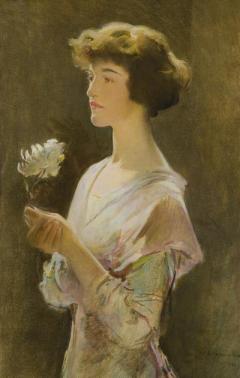John White Alexander
American, 1856 - 1915
Born in Allegheny, Pennsylvania, where he had first-hand knowledge of the tough life of steel workers, John White Alexander became one of the most prominent, fashionable artists in New York City during the late 19th and early 20th centuries. He did portrait, figure, and mural work and is especially noted for female subjects, which he rendered with fluid, sweeping lines and "an almost abstract, decorative rhythm of shape with a graceful and voluptuous expressiveness" As a young man, he worked as a telegraph messenger boy but soon was discovered as a talented illustrator. He began his career working in the Art Department of "Harper's Weekly" as a political cartoonist and illustrator. The 1877 Pittsburgh strike was a special focus. As a part of his assignments he did field work in New Orleans in 1881, and in 1883 was sent to Yellowstone to capture the beauty of the geysers with ink drawings which were then converted to wood engravings. He worked en plein aire to make the originals. He traveled in Europe with Frank Duveneck and William Merritt Chase, attended the Royal Academy in Munich, and in Venice became acquainted with the Tonalist style of painting through James McNeill Whistler. In 1887, he married Elizabeth Alexander, a writer of short stories for whom he had illustrated, and from 1890 for ten years, they lived in Paris where he became a leading proponent of the Art Nouveau movement. In Paris, he did some of his most powerful and imaginative work, including a number of portraits and elongated female figures in dimly lit backgrounds. Among his circle of friends were Oscar Wilde, Henry James, James Whistler, Auguste Rodin and Andre Gide. In 1894, he was voted a member of the Societe National des Beaux Arts and in 1901 was made Knight of the Legion of Honor by the French government. For "Harpers" and "Century Magazine," he created his portraits of European dignitaries, and in 1901, he and his wife settled in New York where he became a portrait painter of scores of prominent people. He was immediately elected to membership of the National Academy of Design and served as President from 1909 to 1915. He also did mural commissions including one for the Carnegie Institute, Pittsburgh, which to that time was the largest mural ever painted by an American. He also received a commission to execute a series of murals, "The Evolution of the Book," for lunettes in the Library of Congress. In 1890, Alexander and his wife briefly visited the Cornish, New Hampshire Art Colony, where he painted landscapes.
John White Alexander Paintings
John White Alexander Paintings
John White Alexander, who was orphaned at an early age, worked hard to become an artist--first as a messenger in his native Allegheny, Pennsylvania, and then as an illustrator in New York City-- and ultimately became one of the most sought-after portraitists of America's Gilded Age. By 1877 he had enough money to go to Europe, where he hoped to study in Paris. When he was not readily accepted into an atelier there, he entered the Royal Academy in Munich. Within a few months he joined a group of American students who painted with the Munich-trained American artist Frank Duveneck (1848-1919) at nearby Polling. Known as
"Duveneck's Boys,"
several of the young artists, including Alexander, went with Duveneck to Venice, where the expatriate American artist James Abbott McNeill Whistler (1834-1903) was then working. Whistler's "
art for art's sake
" approach to painting was a potent influence on Alexander's evolving style.
Alexander returned to New York in 1881 and worked once again as an illustrator, while also seeking portrait commissions. His painting style matured during the course of further European travel (notably to Spain during the 1880s), and the decade he spent in Paris following his marriage gave his portraiture confidence and sophistication. Alexander spent the rest of his life in the United States, where he painted murals as well as portraits. Honors included election to the National Academy of Design in New York, which he served as president from 1909 to 1913.
Biography courtesy of Schwarz Gallery, www.antiquesandfineart.com/schwarzphila
Alexander returned to New York in 1881 and worked once again as an illustrator, while also seeking portrait commissions. His painting style matured during the course of further European travel (notably to Spain during the 1880s), and the decade he spent in Paris following his marriage gave his portraiture confidence and sophistication. Alexander spent the rest of his life in the United States, where he painted murals as well as portraits. Honors included election to the National Academy of Design in New York, which he served as president from 1909 to 1913.
Biography courtesy of Schwarz Gallery, www.antiquesandfineart.com/schwarzphila
John W. Alexander was born in 1856 in Allegheny, Pennsylvania. During his artistic career he was a dedicated member of both the Munich and Vienna Secession, associated with Art Noveau style. Alexander worked as an illustrator for Harper's weekly from 1873-76, before moving to Munich with a small group of Americans. He studied for three months at the Munich Royal Academy and traveled Europe meeting other artists such as Whistler. Alexander moved to Paris in 1889 for three years where he began to work with the Symbolists as well as painting portraits of literary greats like Mark Twain and Walt Whitman. Although murals made up a large portion of Alexander's career, he also worked with oils. His subjects in oil painting were usually figurative pieces showing a single female in a dramatic gown against a contrasting background. In 1895 Alexander was commissioned by the Library of Congress to paint 48 mural panels at the Carnegie Institute for which he would receive $175,000, the largest sum ever paid to date for a mural. Unfortunately, he died in 1915 before being able to complete this work.
Biography courtesy of The Caldwell Gallery, www.antiquesandfineart.com/caldwell
Biography courtesy of The Caldwell Gallery, www.antiquesandfineart.com/caldwell

















